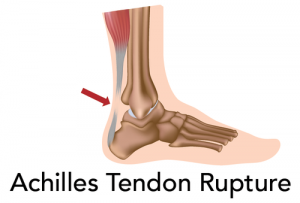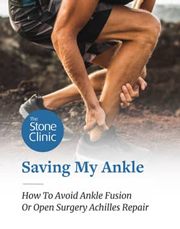Achilles Tendon Repair Rehab Protocol
Below we outline the steps that we have our patients take to recover from a percutaneous Achilles tendon repair surgery. You may learn more about how The Stone Clinic repairs Achilles tendon ruptures without open surgery in our explanation of Achilles tendon injury, diagnosis, and treatment.

General Considerations
- Time frames mentioned in this protocol should be considered approximate with actual progression based upon clinical presentation, physician appointments, as well as continued assessment by the treating practitioner should dictate progress.
- Avoid forceful active and passive range of motion of the Achilles for 10 - 12 weeks.
- Carefully monitor the tendon and incisions for mobility and signs of scar tissue formation. Regular soft tissue treatments (i.e. scar mobilization and friction massage) to decrease fibrosis.
- No direct scar mobilization at surgical portals until 4 weeks post-operative, “no-touch zone” 2 inches from portals. See wound care protocol for full details.
- All exercises should be carefully observed for any signs of compensation or guarding.
- No running, jumping, or ballistic activities for 6 months.
- Aerobic and general conditioning throughout the rehabilitation process.
- M.D./nurse appointments at Day 1-2, Day 14, 1 month, 3 months, 6 months, and 1-year post-op.
Weeks 0 - 3
- Appointment with nurse Day 2 for dressing change and review home program.
- Appointment with nurse Day 14 for stitch removal.
- Adjustable boot locked out at 30degrees of plantar flexion.
- Nonweightbearing for 3 weeks--no push off or toe-touch walking.
- Pain and edema control (i.e. cryotherapy, electric stimulation, soft tissue treatments).
Manual
- Soft tissue mobilization to ankle/foot/effleurage for edema.
- Avoid direct palpation to suture line (keep 2 inch “no-touch zone” around portals x 4 weeks).
Exercises
- Toe curls, toe spreads, gentle foot movement in boot, straight leg raises, knee flexion/extension.
- Well-leg cycling, weight training, and swimming for cardiovascular.
Goals
- Decrease pain, edema. Gait non-weight bearing with axillary crutches/boot.
Weeks 3 - 8
- Walking orthosis set at 30 degrees plantar flexion at 3 weeks; adjust 10 degrees per week.
- Gradually increase weight-bearing from toe-touchdown to partial as tolerated and as able per range of motion (heel contact once partial weight-bearing).
- After 6 weeks, okay to progress to full weight-bearing.
Manual
- Soft tissue mobilization to ankle, foot, effleurage for edema.
- Initiate gentle passive range of motion dorisflexion (not past neutral), inversion, eversion per tolerance- cautious for percutaneus, open repair more stable.
- At 4 weeks initiate scar mobilization once incisions completely closed.
Exercises
- Straight leg raises, side-lying hip abduction, Straight legged bridges.
- Isometrics of uninvolved muscles.
- Light active dorsiflexion of the ankle until gentle stretch of Achilles after 4 weeks.
- Slowly increase the intensity and ranges of isometrics of Achilles within the range of the boot.
- Slowly increase passive range of motion and stretch on the Achilles after 6 weeks.
- Proprioception exercises, intrinsic muscle strengthening, PNF patterns for hip and knee (not to Achilles).
- At 6 weeks, okay to add stationary cycling with heel push only.
Goals
- 0 degrees Dorsiflexion.
- After 6 weeks progress to full weight-bearing, discharge crutches.
Weeks 8 - 12
- After 8 weeks, okay to wear shoes with a heel (i.e. cowboy boots, 1/4 " heel lift in shoes).
- Full weight-bearing with heel lift as tolerated, gait training.
- Wean into a regular shoe over a 2-4 week period.
Manual
- Continue with soft tissue mobilization, range of motion, joint mobilizations as needed.
Exercises
- Begin and gradually increase active / resistive exercises of the Achilles (i.e. submaximal isometrics, cautious isotonics, Theraband).
- progress to cycling in shoe, swimming (no fins).
Goals
- Full range of motion ankle.
- Tolerance to regular shoe, good gait mechanics.
Months 3 - 6
- Wean off heel lifts (if not already).
- Complete Sport Test 1.
Exercises
- Closed chain exercises: controlled squats, lunges, bilateral calf raise (progress to unilateral), toe raises, controlled slow eccentrics vs. body weight.
- Cycling, VersaClimber, rowing machine, Nordic Track (gradually).
- Unless excessive fibrosis present, should be discharged into a home program.
Goals
- Complete and pass Sport Test 1. Strength 5/5.
- Able to perform single-leg calf raise.
Months 6
- Complete Sport Test 2. Progress training jogging / running, jumping and eccentric loading exercises, non-competitive sporting activities, sports-simulated exercises.
Months 8 - 9
- Return to physically demanding sport and/or work.
NOTE: All progressions are approximations and should be used as a guideline only. Progression will be based on individual patient presentation, which is assessed throughout the treatment process.
How We Repair Achilles Ruptures & Tears Without "Open" Surgery
Need help recovering from surgery? Our Stone Fit Physical Therapy San Francisco team can help with customized one-on-one programs to return you to full activity fitter, faster, and stronger than you’ve been in years.
